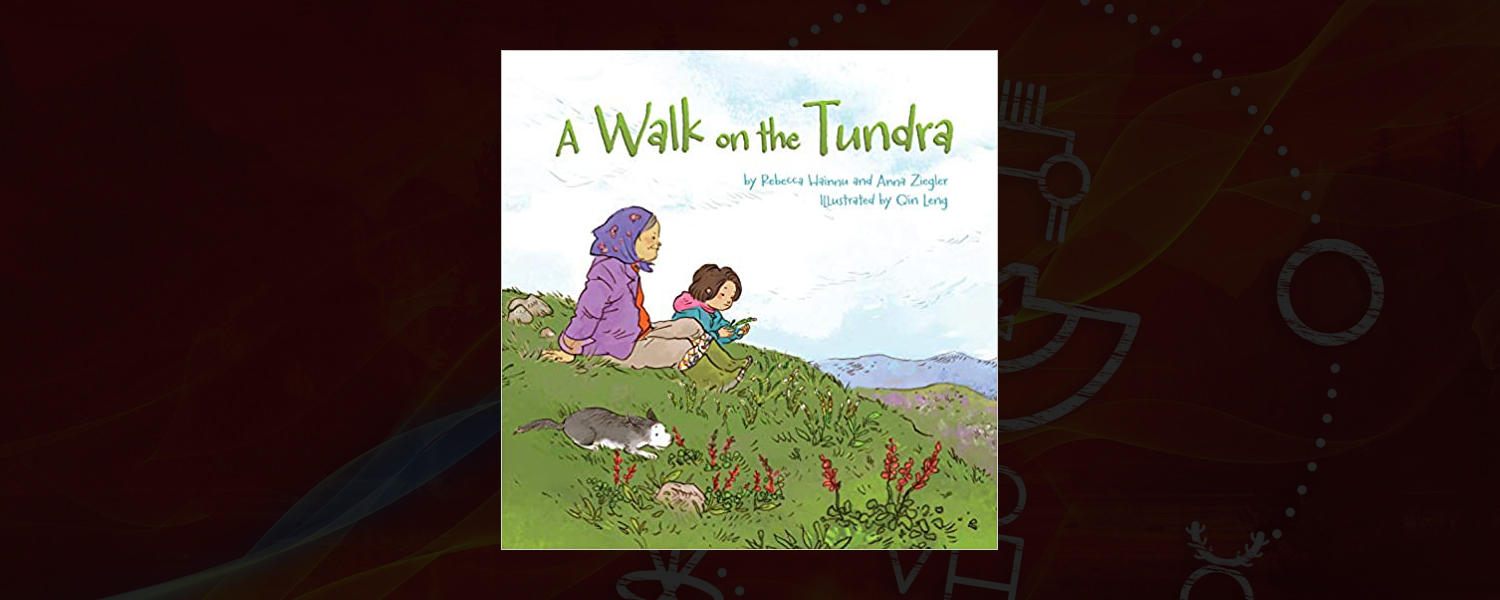
A Walk on the Tundra
by Rebecca Hainnu, Qin Leng, & Anna Ziegler
Description:
Publisher's description (Inhabit Media):
During the short Arctic summers, the tundra, covered most of the year under snow and ice, becomes filled with colourful flowers, mosses, shrubs, and lichens. These hardy little plants transform the northern landscape, as they take advantage of the warmer weather and long hours of sunlight. Caribou, lemmings, snow buntings, and many other wildlife species depend on tundra plants for food and nutrition, but they are not the only ones... A Walk on the Tundra follows Inuujaq, a little girl who travels with her grandmother onto the tundra. There, Inuujaq learns that these tough little plants are much more important to Inuit than she originally believed. In addition to an informative storyline that teaches the importance of Arctic plants, this book includes a field guide with photographs and scientific information about a wide array of plants found throughout the Arctic.
Find an adult education book study unit for free available on the publisher's website.
Creator Biographies (Inhabit Media and Strong Nations):
Rebecca Hainnu lives in Clyde River with her daughters. Her work includes Math Activities for Nunavut Classrooms and Classifying Vertebrates. She is also the author of The Spirit of the Sea. Her book A Walk on the Tundra, co-authoured with Anna Ziegler, was a finalist for the 2013 Canadian Children’s Literature Round Table Information Book Award, and was among the 2012 “Best Books for Kids and Teens,” as selected by the Canadian Children’s Book Centre.
Anna Ziegler lives in Iqaluit, where she works at Nunavut Arctic College as an instructor and regional program coordinator. She is the co-author, with Rebecca Hainnu, of A Walk on the Tundra, and author of Tukisigiaruti Qaujisaqtulirinirmut: A Life Sciences Handbook for Nunavut Educators.
Qin Leng was born in Shanghai and lived in France and Montreal. She now lives and works as a designer and illustrator in Toronto. Her father, an artist himself, was a great influence on her. She grew up surrounded by paintings, and it became second nature for her to express herself through art. She graduated from the Mel Hoppenheim School of Cinema and has received many awards for her animated short films and artwork. Qin has always loved to illustrate the innocence of children and has developed a passion for children’s books. She has illustrated numerous picture books for publishers in Canada, the United States, and South Korea.
Resource format: Picturebook
Age recommendation: Grade 2 - 6
Keywords: Arctic, tundra, envioronment, Northern landscape, land, land based learning, plants, language revitilization, family, Inuktitut, bored, emotions, friends, elders, grandma, learning, foraging, explore, dog, anaanatsiaq, qunnguliit, nirilikkit, inspect, share, qijuktaat, tea, medicine, plant uses, traditional knowledge, plant glossary, Inuktitut glossary, Inuk, Inuit, Nunavut
Year of publication: 2011
Publisher information: Inhabit Media
Teaching and Learning Ideas
Our team collaborated with new teachers, alumni of the Werklund School of Education’s Bachelor of Education program, to create teaching and learning plans for texts in this website. With audiences ranging from Pre-Kindergarten to Post-Secondary, lesson plans across this resource address a wide range of school subject areas, inclusive approaches, and Indigenous education topics, such as the revitalization of Indigenous languages. As this website was designed with Undergraduate Programs in Education instructors, as well as teachers in mind, connections to UPE courses have been flagged on each lesson plan. These lessons are intended as a starting place for educators, to help you envision ways in which you might bring Indigenous literatures, as well as ways of knowing, being, and doing, into your teaching contexts. Please adapt, use, and share these lessons in ways that are generative for your teaching practice. We offer our sincere thanks to the dozens of new teachers who gifted us with these creative ideas!
Return to Search for Resources
